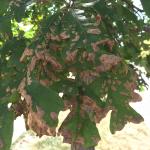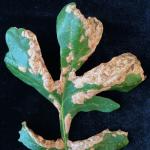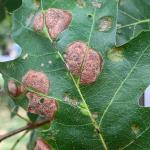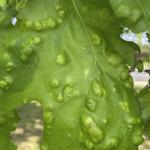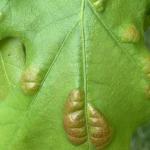Oak Leaf Blister
Pathogen
The fungal pathogen Taphrina caerulescens causes oak leaf blister (Sinclair and Lyon 2005).
Hosts
Taphrina caerulescens infects a wide variety of Quercus species across the globe. Based on samples submitted to the UMass Plant Diagnostic Lab and observations across the UMass campus, the following oak species serve as hosts in the region: white oak (Q. alba), scarlet oak (Q. coccinea), bur oak (Q. macrocarpa), pin oak (Q. palustris), English oak (Q. robur), northern red oak (Q. rubra), and black oak (Q. velutina).
Symptoms & Signs
Historically, oak leaf blister has been a more common and destructive disease in the southeast US (Sinclair and Lyon 2005). However, in recent years, diagnostic samples and observations of the disease have increased significantly across southern New England. Taphrina infects newly developing leaves as the buds open in the spring but symptoms may not be conspicuous until later in the growing season. As the infected leaves are maturing, the fungus grows within the epidermis, beneath the cuticle. The resulting lesions appear convex (raised) on the upper surface of the leaf while on the underside they appear convex (depressed). Initially, the lesions may appear light green to reddish in color, becoming reddish-brown to tan as the tissue is killed and becomes dry. When numerous lesions develop on an infected leaf they can coalesce to cause a total collapse. Taphrina sporulates from the blighted sections of the foliage but these spores do not reinfect the host to cause additional disease. Instead, they disperse onto nearby twigs or bud scales where they remain dormant, allowing the fungus to overwinter in the canopy. Thus, when the buds open and new leaves develop the following spring, the pathogen is in very close proximity to initiate a new infection cycle. High levels of oak leaf blister can result in stunted growth and reduced vigor, making trees susceptible to opportunistic pests and pathogens.
Management
In most cases, oak leaf blister does not cause serious damage to affected oaks in the northeastern US. Additionally, when outbreaks are severe during a particular year, disease pressure may be low in subsequent years. Disease incidence can also be patchy across the landscape with badly infected trees in close proximity to trees with only low levels of injury (Sinclair and Lyon 2005). In most cases, fungicide application is not recommended to control oak leaf blister. However, for specimen or newly transplanted trees under stress, fungicides can be applied late in winter dormancy, before bud break, to kill overwintering spores before they can infect the newly developing foliage in the spring. Fungicides labeled for use include copper-based products and mancozeb.
Citation
Sinclair WA. and Lyon HH. 2005. Diseases of Trees and Shrubs, 2nd edn. Cornell University Press, Ithaca, NY.
